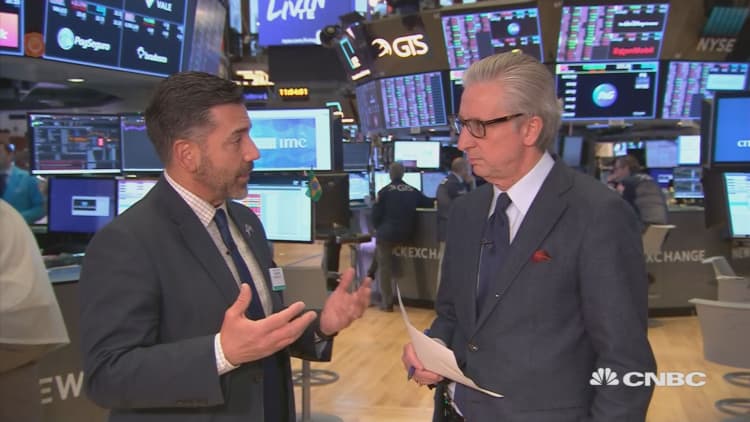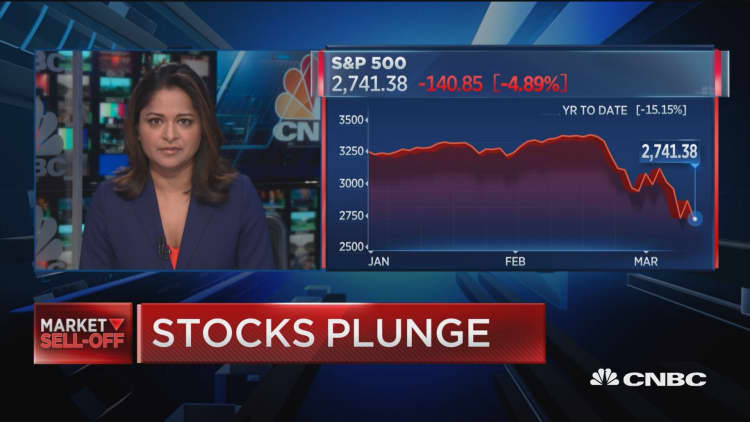PUBLISHED WED, MAR 12, 2020

Steve Grasso: Markets looking for clarity
U.S. stocks recovered some of their steep losses on Thursday after the Federal Reserve announced extraordinary funding actions to ease strained capital markets in the wake of the coronavirus sell-off.
The Dow Jones Industrial Average traded 826 points lower, or 3.5% after plummeting more than 9% for its worst drop since the 1987 market crash. It was on pace for the sixth-worst decline for the Dow in history, according to FactSet. Even the worst one-day drop of 2008 financial crisis did not reach this magnitude.
The S&P 500 traded down 4.4%, joining the Dow in a bear market on Thursday. The main U.S. stock benchmark is now down 22% from its record set just last month. At one point, however, the S&P 500 was down more than 9%. The Nasdaq Composite recovered slightly, trading about 4.5% lower after plummeting more than 7%.
The Fed announced it will ramp up its overnight funding operations to more than $500 billion.
Stocks have been under pressure were initially under pressure since President Donald Trump failed to quell concerns over the possible economic slowdown stemming from the coronavirus.
It got so bad, that trading was halted briefly after the open for 15 minutes as markets hit the mandated “circuit-breaker” threshold used by U.S. exchanges. Not much was immune to the market plunge. Small-cap benchmark the Russell 2000 index cratered by 10%. Gold fell. Oil plunged. Credit market spreads widened significantly. Only U.S. Treasuries were higher. Even bitcoin dropped.
“We are going into a global recession,” said Mohamed El-Erian, chief economic adviser at Allianz, on CNBC’s “Squawk Box.” “After what’s been happening the last few days, we are going to see a spread of economic sudden stops.”
“The trouble with economic sudden stops is it’s not easy to restart an economy,” El-Erian said. He believes the selling won’t stop until the bear market hits down 30%.

In his address, Trump announced travel from Europe will be suspended for 30 days as part of the government’s response to the coronavirus outbreak. Trump also said the administration would provide financial relief for workers who are ill, caring for others due to the virus or are quarantined.
These moves were not specific enough for investors, however, who were looking for a more robust fiscal response to curb potentially slower economic growth stemming from the coronavirus.
“President Trump in an extraordinary Oval Office address didn’t offer up major new ideas on stimulus and only said he’d propose a vague payroll tax holiday to Congress without strongly standing up for any firm size/magnitude,” wrote Ernie Tedeschi, policy economist for Evercore ISI, in a note. “This effectively kicks the issue to Congress which is still planning to go on recess next week.”
Cruise line shares dropped sharply. Royal Caribbean traded 26.6% lower while Carnival and Norwegian Cruise Line slid 19% and 27.6%, respectively. Airline shares such as United, Delta and American all fell more than 12%.
The Cboe Volatility Index (VIX), widely considered the best fear gauge on Wall Street, jumped to more than 67 and hit its highest level since 2008.
On Wednesday, the Dow ended its historic 11-year bull market run by closing in bear-market territory. A bear market marks a 20% decline from all-time highs. Now the S&P 500 is in one.

Trading was halted for 15 minutes shorty as an initial 7% drop triggered “circuit breakers” at the New York Stock Exchange and Nasdaq. Before the open, futures contracts overnight tied to the major indexes fell to their so-called limit down thresholds, sliding 5%. These limit down levels act as a floor for selling until regular trading begins. They are used to ensure orderly markets.
Also causing concern about how pervasive the virus could already be in this country was the announcement Wednesday that the National Basketball Association is suspending its season after a Utah Jazz player tested positive for coronavirus. Movie actor Tom Hanks and his wife, Rita Wilson, also said they tested positive for the coronavirus.
“The crux of the angst investors are feeling as the coronavirus spreads surrounds what might happen to consumer spending,” wrote Scott Wren, senior global market strategist at Wells Fargo Investment Institute.
“Consumers sitting at home and not out spending money because they fear catching the coronavirus is the ultimate negative outcome,” he added. “It has been the U.S. consumer who has been driving the recovery bus during this long expansion.”
Thursday’s plunge came after yet another wild session on Wall Street and the demise of the Dow’s record-setting bull market run that began in March 2009. The blue-chip index tumbled 1,464.94 points, or 5.9%, to close at 23,553.22. The 30-stock average closed in a bear market, putting to end an expansion that started in 2009 amid the financial crisis.
The S&P 500 and Nasdaq Composite fared slightly better on Wednesday, down 4.89% and 4.7% respectively. Those two indexes also remain just outside of bear market territory albeit down at least 19% from their respective record closes.

“These markets have been impossible to predict,” said David Lafferty, chief market strategist at Natixis Investment Managers. “I think of them as kind of wind-sock markets. They’re just changing with whatever way sentiment is. There’s no fundamentals under these markets right now.”
Investors continued to blame the spread and economic impact of the coronavirus for the last month’s steep losses. The virus, which has now infected more than 124,000 people worldwide and killed at least 4,589, threatens to disrupt countries like Italy that have taken aggressive action to slow its spread. Italian Premier Giuseppe Conte announced late Wednesday that all the country’s stores except pharmacies and groceries will be closed in a move deemed both necessary to safeguard human health and a threat to the country’s output.
Wall Street worries that such measures could tip the global economy into recession, especially if Washington decides the disease is rampant enough in the U.S. to warrant similar measures. The World Health Organization declared COVID-19 a pandemic earlier on Wednesday.
—CNBC’s Eustance Huang contributed to this report.
Fed to pump more than $1 trillion in dramatic ramping up of market intervention
CNBC PUBLISHED THU, MAR 12 2020
KEY POINTS
The Fed announced a bold new initiative Thursday in an effort to calm market tumult.
In all, the new moves pump in up to $1.5 trillion into the financial system in an effort to combat potential freezes brought on by the coronavirus.
This was the second day in a row and the third time this week the Fed has stepped in.
Stocks staged a sharp turnaround from earlier losses, though some of those gains were pared.
The Federal Reserve has stepped into financial markets for the second day in a row and the third time this week, this time dramatically ramping up asset purchases amid the turmoil created by the coronavirus.
“These changes are being made to address highly unusual disruptions in Treasury financing markets associated with the coronavirus outbreak,” the New York Fed said in a statement released early Thursday afternoon amid a washout on Wall Street that was heading toward the worst day since 1987.
Stocks were off their lows following the announcement though some of the gains were pared as the market digested the moves.
One part of the announcement saw the Fed widen the scale for its $60 billion worth of money Treasury purchases, which to now had been confined to short-term T-bills.
Under the new regime, the Fed will extend its purchases “across a range of maturities” to include bills, notes, Treasury Inflation-Protected Securities and other instruments. The central bank will begin purchasing coupon-bearing securities, something market participants have been clamoring for since late 2019.
The purchases start Thursday and will continue through April 13.
The second part of the new operations will see the New York Fed desk offer $500 billion in a three-month repo operation and a one-month operation. The offerings will happen on a weekly basis through the remainder of the program.
In addition, the Fed will continue to offer at least $175 billion in overnight repos and $45 billion in two-week operations. Repos are short-term operations in which financial institutions provide high-quality collateral in exchange for cash reserves they use to operate.
The extraordinary moves come amid extreme market turmoil created by uncertainty over the coronavirus spread. Government bond yields earlier this week cascaded to record lows amid reports of liquidity issues in the market and fears of a global recession.
Markets have been looking for action by the Fed, which instituted an inter-meeting interest rate cut last week that did nothing to quell concerns. The Fed on Monday increased the limits for its ongoing repo operations, then Wednesday expanded the limits an announced a $50 bill term offering that attracted heavy interest earlier in the day Thursday.
The extraordinary moves come amid extreme market turmoil created by uncertainty over the coronavirus spread. Government bond yields earlier this week cascaded to record lows amid reports of liquidity issues in the market and fears of a global recession.
Markets have been looking for action by the Fed, which instituted an inter-meeting interest rate cut last week that did nothing to quell concerns. The Fed on Monday increased the limits for its ongoing repo operations, then Wednesday expanded the limits an announced a $50 bill term offering that attracted heavy interest earlier in the day Thursday.
No comments:
Post a Comment